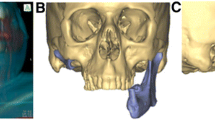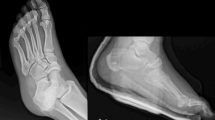Abstract
In computer-assisted maxillofacial trauma repair, the algorithm >diagnosis → planning and simulation → surgical procedure → validation and quality control< has been established.
The focus of diagnosis is on 3D imaging especially on computed tomography findings. Planning and simulation involve the creation of virtual 3D models of the desired surgical outcome by the use of special planning software. The generated virtual reconstructions can be used for designing and manufacturing patient-specific implants afterwards. During the surgical procedure, planning must be transferred to the surgical site as accurately as possible. For this purpose, open reduction with the placement of anatomically preformed or patient-specific implants, in combination with the use of intraoperative navigation and/or surgical guides are employed. Validation and quality control require postprocedural 3D imaging as well. After reconstructions of the midface and the mandibular condyles, 3D imaging is recommended to be performed even before surgery is completed. Mobile 3D C-arms are particularly useful for intraoperative 3D imaging in maxillofacial trauma repair. Malpositions can thus be corrected directly and unnecessary revisions can be avoided.
Access this chapter
Tax calculation will be finalised at checkout
Purchases are for personal use only
Similar content being viewed by others
References
Schramm A, Gellrich NC. Intraoperative Navigation und computerassistierte Chirurgie. In: Schwenzer N, Ehrenfeld M, editors. Zahn-Mund-Kieferheilkunde, Mund-Kiefer-Gesichtschirurgie, vol. 2011. 4th ed. Stuttgart: Thieme; 2011. p. 479–99.
Schramm A, Wilde F. Die computergestützte Gesichtsschädelrekonstruktion. HNO 2011;59:800–6.
Markiewicz MR, Bell RB. Modern concepts in computer-assisted craniomaxillofacial reconstruction. Curr Opin Otolaryngol Head Neck Surg. 2011;19:295–301.
Wilde F, Schramm A. Intraoperative imaging in orbital and midface reconstruction. Facial Plast Surg. 2014;30:545–53.
Parthasarathy J. 3D modeling, custom implants and its future perspectives in craniofacial surgery. Ann Maxillofac Surg. 2014;4:9–18.
Manson PN, Markowitz B, Mirvis S, Dunham M, Yaremchuk M. Toward CT-based facial fracture treatment. Plast Reconstr Surg. 1990;85:202–12.
Tanrikulu R, Erol B. Comparison of computed tomography with conventional radiography for midfacial fractures. Dentomaxillofac Radiol. 2001;30:141–6.
Wilde F, Lorenz K, Ebner AK, Krauss O, Mascha F, Schramm A. Intraoperative imaging with a 3D-C-arm system after zygomatico-orbital complex fracture reduction. J Oral Maxillofac Surg. 2013;71:894–910.
Wikner J, Riecke B, Gröbe A, Heiland M, Hanken H. Imaging of the midfacial and orbital trauma. Facial Plast Surg. 2014;30:528–36.
Cornelius C-P, Gellrich N-C, Hillerup S, Kusumoto K, Schubert W. AO foundation; midface-diagnosis, AO surgery reference. 2014. http://www.aocmf.org/surgeryref.aspx. Accessed 5 Oct 2019.
Schulze D, Heiland M, Thurmann H, Adam G. Radiation exposure during midfacial imaging using 4- and 16-slice computed tomography, cone beam computed tomography systems and conventional radiography. Dentomaxillofac Radiol. 2004;33:83–6.
Ludlow JB, Ivanovic M. Comparative dosimetry of dental CBCT devices and 64-slice CT for oral and maxillofacial radiology. Oral Surg Oral Med Oral Pathol Oral Radiol Endod. 2008;106:106–14.
Loubele M, Bogaerts R, Van Dijck E, Pauwels R, Vanheusden S, Suetens P, Marchal G, Sanderink G, Jacobs R. Comparison between effective radiation dose of CBCT and MSCT scanners for dentomaxillofacial applications. Eur J Radiol. 2009;71:461–8.
Suomalainen A, Kiljunen T, Käser Y, Peltola J, Kortesniemi M. Dosimetry and image quality of four dental cone beam computed tomography scanners compared with multislice computed tomography scanners. Dentomaxillofac Radiol. 2009;38:367–78.
Chau AC, Fung K. Comparison of radiation dose for implant imaging using conventional spiral tomography, computed tomography, and cone-beam computed tomography. Oral Surg Oral Med Oral Pathol Oral Radiol Endod. 2009;107:559–65.
Geibel M-A. DVT – Indikationen und Strahlenbelastung. 2013. http://www.zwp-online.info/de/fachgebiete/digitale-zahnmedizin/digitale-bildgebung/dvt-indikationen-und-strahlenbelastung. Accessed 10 Dec 2019.
Deman P, Atwal P, Duzenli C, Thakur Y, Ford NL. Dose measurements for dental cone-beam CT: a comparison with MSCT and panoramic imaging. Phys Med Biol. 2014;59:3201–22.
Brisco J, Fuller K, Lee N, Andrew D. Cone beam computed tomography for imaging orbital trauma—image quality and radiation dose compared with conventional multislice computed tomography. Br J Oral Maxillofac Surg. 2014;52:76–80.
Schramm A, Gellrich NC, Schmelzeisen R. Navigational surgery of the facial skeleton. Berlin: Springer; 2007.
Markiewicz MR, Bell RB. The use of 3D imaging tools in facial plastic surgery. Facial Plast Surg Clin North Am. 2011;19:655–82.
Wilde F, Hilbert J, Kamer L, Hammer B, Metzger M, Schmelzeisen R, Gellrich N-C, Schramm A. The combination of automatic segmentation, preformed implants, intraoperative imaging in primary orbital wall reconstruction: description of a new method. Int J Comput Assist Radiol Surg. 2009;4(Suppl 1):134.
Schramm A, Gellrich NC, Schön R, Gutwald R, Schmelzeisen R. Navigational maxillofacial surgery using virtual models. In: Tachibana E, Furukawa T, Mukai Y, Ma H, editors. Proceedings of the international symposium modelling applications, Daegu, Korea, 2002. p. 71–6.
Hohlweg-Majert B, Schön R, Schmelzeisen R, Gellrich NC, Schramm A. Navigational maxillofacial surgery using virtual models. World J Surg. 2005;29:1530–8.
Schipper J, Klenzner T, Berlis A, Maier W, Offergeld C, Schramm A, Gellrich NC. Objektivierung von Therapieergebnissen in der Schädelbasischirurgie durch virtuelle Modellanalyse. HNO. 2006;54:677–83.
Metzger MC, Bittermann G, Dannenberg L, Schmelzeisen R, Gellrich NC, Hohlweg-Majert B, Scheifele C. Design and development of a virtual anatomic atlas of the human skull for automatic segmentation in computer-assisted surgery, preoperative planning, and navigation. Int J Comput Assist Radiol Surg. 2013;8:691–702.
Gellrich N-C, Schramm A, Hammer B, Schmelzeisen R. The value of computer-aided planning and intraoperative navigation in orbital reconstruction. Int J Oral Maxillofac Surg. 1999;28:52–3a.
Essig H, Dressel L, Rana M, Rana M, Kokemueller H, Ruecker M, Gellrich NC. Precision of posttraumatic primary orbital reconstruction using individually bent titanium mesh with and without navigation: a retrospective study. Head Face Med. 2013;9:18.
Kernan BT, Wimsatt JA 3rd. Use of a stereolithography model for accurate, preoperative adaptation of a reconstruction plate. J Oral Maxillofac Surg. 2000;58:349–51.
Hallermann W, Olsen S, Bardyn T, Taghizadeh F, Banic A, Iizuka T. A new method for computer-aided operation planning for extensive mandibular reconstruction. Plast Reconstr Surg. 2006;117:2431–7.
Schmelzeisen R, Gellrich NC, Schoen R, Gutwald R, Zizelmann C, Schramm A. Navigation-aided reconstruction of medial orbital wall and floor contour in cranio-maxillofacial reconstruction. Injury. 2004;35:955–62.
Fuller SC, Strong EB. Computer applications in facial plastic and reconstructive surgery. Curr Opin Otolaryngol Head Neck Surg. 2007;15:233–7.
Bell RB, Markiewicz MR. Computer-assisted planning, stereolithographic modeling, and intraoperative navigation for complex orbital reconstruction: a descriptive study in a preliminary cohort. J Oral Maxillofac Surg. 2009;67:2559–70.
Beumer HW, Puscas L. Computer modeling and navigation in maxillofacial surgery. Curr Opin Otolaryngol Head Neck Surg. 2009;17:270–3.
Markiewicz MR, Dierks EJ, Potter BE, Bell RB. Reliability of intraoperative navigation in restoring normal orbital dimensions. J Oral Maxillofac Surg. 2011;69:2833–40.
Austin RE, Antonyshyn OM. Current applications of 3-D intraoperative navigation in craniomaxillofacial surgery: a retrospective clinical review. Ann Plast Surg. 2012;69:271–8.
Yu H, Shen SG, Wang X, Zhang L, Zhang S. The indication and application of computer-assisted navigation in oral and maxillofacial surgery—Shanghai’s experience based on 104 cases. J Craniomaxillofac Surg. 2013;41:770–4.
Novelli G, Tonellini G, Mazzoleni F, Bozzetti A, Sozzi D. Virtual surgery simulation in orbital wall reconstruction: integration of surgical navigation and stereolithographic models. J Craniomaxillofac Surg. 2014;42:2025–34.
Gander T, Essig H, Metzler P, Lindhorst D, Dubois L, Rücker M, Schumann P. Patient specific implants (PSI) in reconstruction of orbital floor and wall fractures. J Craniomaxillofac Surg. 2015;43:319–22.
Vandenbroucke B, Kruth JP. Selective laser melting of biocompatible metals for rapid manufacturing of medical parts. Rapid Prototyp J. 2007;13:196–203.
Bilz M, Uhlmann E. Generative manufacturing methods: selective laser melting. 2014. http://www.ipk.fraunhofer.de/fileadmin/user_upload/IPK_FHG/publikationen/themenblaetter/ps_ft_selective_laser_melting_en.pdf. Accessed 10 Oct 2019.
Heiland M, Schmelzle R, Hebecker A, Schulze D. Intraoperative 3D imaging of the facial skeleton using the SIREMOBIL Iso-C3D. Dentomaxillofac Radiol. 2004;33:130–2.
Heiland M, Schulze D, Blake F, Schmelzle R. Intraoperative imaging of zygomaticomaxillary complex fractures using a 3D-C-arm system. Int J Oral Maxillofac Surg. 2005;34:369–75.
Klatt J, Heiland M, Blessmann M, Blake F, Schmelzle R, Pohlenz P. Clinical indication for intraoperative 3D imaging during open reduction of fractures of the neck and head of the mandibular condyle. J Craniomaxillofac Surg. 2011;39:244–8.
Hanken H, Christian L, Assaf AT, Heiland M. Intraoperative Bildgebung in der Mund-, Kiefer- und Gesichtschirurgie. Intraoperative imaging of the facial skeleton. OP J. 2013;29:130–5.
Gebhard F, Riepl C, Richter P, Liebold A, Gorki H, Wirtz R, König R, Wilde F, Schramm A, Kraus M. Der Hybridopertionssaal. Zentrum intraoperativer Bildgebung. Unfallchirurg. 2012;115:107–20.
Author information
Authors and Affiliations
Corresponding author
Editor information
Editors and Affiliations
Rights and permissions
Copyright information
© 2021 Springer Nature Switzerland AG
About this chapter
Cite this chapter
Wilde, F., Schramm, A. (2021). Computer-Assisted Surgery and Intraoperative Navigation in Acute Maxillofacial Trauma Repair. In: Acero, J. (eds) Innovations and New Developments in Craniomaxillofacial Reconstruction. Springer, Cham. https://doi.org/10.1007/978-3-030-74322-2_5
Download citation
DOI: https://doi.org/10.1007/978-3-030-74322-2_5
Published:
Publisher Name: Springer, Cham
Print ISBN: 978-3-030-74321-5
Online ISBN: 978-3-030-74322-2
eBook Packages: MedicineMedicine (R0)




